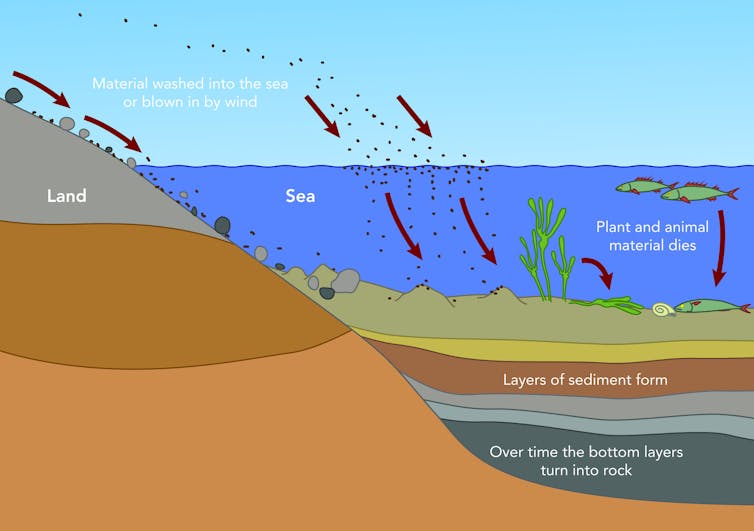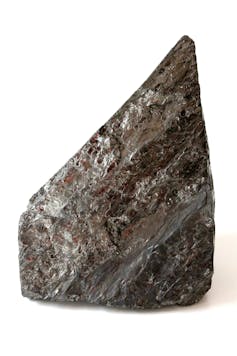While many rocks don’t burn, some of them do. It depends on what the rocks are made of – and that’s related to how they were formed.
There are three main rock types: igneous, sedimentary and metamorphic. These rocks are made of minerals that all have different characteristics. Some will melt into magma or lava – super-hot, liquid rock – when they are exposed to heat. Others will catch fire.
Rocks can look alike, but one rock is not like another.
Rocks that burn when they get heated up are combusting. This means that elements within the rocks are reacting with oxygen in the air to produce heat and light, in the form of flames.
The elements sulfur, carbon and hydrogen easily react with oxygen. Rocks that contain these elements are combustible. Without these elements inside them, rocks that are exposed to enough heat will melt instead of catching fire.
How rocks form
Igneous rocks are formed when magma underground or lava from a volcano cools and crystallizes into solid material. These rocks are mostly made of silicate minerals that crystallize at temperatures from 1,300 degrees Fahrenheit (700 degrees Celsius) up to as high as 2,400 F (1,300 C).
Igneous rocks contain few or no combustible elements. And it’s very hard to remelt them back into magma because they crystallize at such high temperatures – it would take the kind of high-tech incinerator that cities use to burn waste to make that happen.
Sedimentary rocks have a very different formation story. They form from broken bits of rocks, minerals, sometimes plant or animal material, and also crystals left behind when water evaporates, like the limescale that forms in teakettles and bathtubs.
Sedimentary rock forms when layers of material are compressed over time, either on land or under water. Siyavula Education/Flickr, CC BY
There is a lot of sulfur, carbon and hydrogen in living things. In fact, these are three of the six essential elements of life on Earth. Bits of organic matter, particularly dead plants, also are combustible and allow the rocks to burn.
The last group of rocks is called metamorphic, because these rocks form when a lot of heat and pressure change existing rocks into new types without melting or burning them. “Metamorphosis” comes from ancient Greek and means “transformation.” For example, marble that you might see in kitchen counters or statues came from limestone that was transformed under intense heat and pressure deep underground.
The rock that humans burn: Coal
Metamorphic rocks that are formed from igneous rocks won’t contain the combustible elements – the ones that burn – but metamorphic rocks made from sedimentary rocks might. One familiar example is anthracite coal, which is made almost entirely of carbon. It formed when dead plants fell into swamps long, long ago, were buried by sand or mud, and eventually were compressed over hundreds of millions of years into coal.
Anthracite is the hardest type of coal. It contains the most carbon and the fewest impurities of all coal types. Jakec/Wikipedia, CC BY-SA
There are many coal seams around the world. Sometimes the coal even catches fire while it’s still in the ground. The cause can be natural, such as a lightning strike, or human activities like mining.
In Centralia, Pennsylvania, a former mining town, a coal seam has been burning for over 50 years. There are other active coal seam fires in places around the world including Zimbabwe in Africa and Jharia in India.
If carbon is compressed with even more pressure than it takes to make coal, eventually you get diamonds – the hardest mineral found in nature. In 1772, French chemist Antoine Lavoisier proved that diamonds could combust when he burned one with a magnifying glass.
Scientists burn a diamond – the hardest mineral found in nature.
With enough patience, you could burn a diamond in a candle flame. But since diamonds are quite expensive, it’s better to stick to burning other things made of carbon, like leaves under a magnifying glass, or sticks and marshmallows in a campfire, instead.



 A Nasa rover has reached a promising place to search for fossilised life on Mars
A Nasa rover has reached a promising place to search for fossilised life on Mars  Why some people don't trust science – and how to change their minds
Why some people don't trust science – and how to change their minds  Orbital resonance − the striking gravitational dance done by planets with aligning orbits
Orbital resonance − the striking gravitational dance done by planets with aligning orbits  Spacesuits need a major upgrade for the next phase of exploration
Spacesuits need a major upgrade for the next phase of exploration  Dark matter: our new experiment aims to turn the ghostly substance into actual light
Dark matter: our new experiment aims to turn the ghostly substance into actual light  Black hole, neutron star or something new? We discovered an object that defies explanation
Black hole, neutron star or something new? We discovered an object that defies explanation  Larger and more frequent solar storms will make for potential disruptions and spectacular auroras on Earth
Larger and more frequent solar storms will make for potential disruptions and spectacular auroras on Earth  How do airplanes fly? An aerospace engineer explains the physics of flight
How do airplanes fly? An aerospace engineer explains the physics of flight  The brain is the most complicated object in the universe. This is the story of scientists’ quest to decode it – and read people’s minds
The brain is the most complicated object in the universe. This is the story of scientists’ quest to decode it – and read people’s minds  Why is the universe ripping itself apart? A new study of exploding stars shows dark energy may be more complicated than we thought
Why is the universe ripping itself apart? A new study of exploding stars shows dark energy may be more complicated than we thought  Could a telescope ever see the beginning of time? An astronomer explains
Could a telescope ever see the beginning of time? An astronomer explains  Alpha, beta, theta: what are brain states and brain waves? And can we control them?
Alpha, beta, theta: what are brain states and brain waves? And can we control them?  What is minoxidil, the anti-balding hair growth treatment? Here’s what the science says
What is minoxidil, the anti-balding hair growth treatment? Here’s what the science says  The mystery of consciousness shows there may be a limit to what science alone can achieve
The mystery of consciousness shows there may be a limit to what science alone can achieve 
































